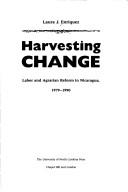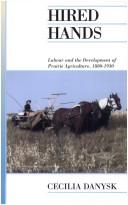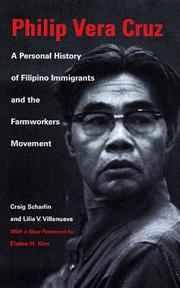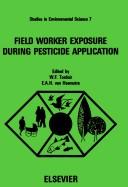| Listing 1 - 10 of 31 | << page >> |
Sort by
|
Book
ISBN: 0128172681 0128164093 9780128172681 9780128164099 Year: 2019 Publisher: London, United Kingdom : Academic Press, an imprint of Elsevier,
Abstract | Keywords | Export | Availability | Bookmark
 Loading...
Loading...Choose an application
- Reference Manager
- EndNote
- RefWorks (Direct export to RefWorks)
The Farm Labor Problem: A Global Perspective explores the unique character of agricultural labor markets and the implications for food production, farm worker welfare and advocacy, and immigration policy. Agricultural labor markets differ from other labor markets in fundamental ways related to seasonality and uncertainty, and they evolve differently than other labor markets as economies develop. We weave economic analysis with the history of agricultural labor markets using data and real-world events. The farm labor history of California and the United States is particularly rich, so it plays a central role in the book, but the book has a global perspective ensuring its relevance to Europe and high-income Asian countries. The chapters in this book provide readers with the basics for understanding how farm labor markets work (labor in agricultural household models, farm labor supply and demand, spatial market equilibria); farm labor and immigration policy; farm labor organizing; farm employment and rural poverty; unionization and the United Farm Workers movement; the Fair Food Program as a new approach to collective bargaining; the declining immigrant farm labor supply; and what economic development in relatively low-income countries portends for the future of agriculture in the United States and other high-income countries. The book concludes with a chapter called "Robots in the Fields," which extrapolates current trends to a perhaps not-so-distant future. The Farm Labor Problem serves as both a guide to policy makers, farmworker advocates and international development organizations and as a textbook for students of agricultural economics and economics.
Agricultural laborers. --- Labor market. --- Employees --- Market, Labor --- Supply and demand for labor --- Markets --- Agricultural workers --- Farm labor --- Farm laborers --- Farm workers --- Farmhands --- Farmworkers --- Supply and demand --- E-books

ISBN: 0807843156 0807819573 0807861278 9780807861271 9780807837993 0807837997 9798890865250 Year: 1991 Publisher: Chapel Hill, N.C. University of North Carolina Press
Abstract | Keywords | Export | Availability | Bookmark
 Loading...
Loading...Choose an application
- Reference Manager
- EndNote
- RefWorks (Direct export to RefWorks)
One of the principal aims of the Sandinista government in Nicaragua was to end the exploitation of the rural poor. But its attempts to promote balanced economic development and redistribute agricultural resources created labor shortages that threatened the country's economic lifeline. New employment opportunities created through agrarian reform upset the delicate balance developed in pre-revolution years to meet the labor requirements of Nicaragua's two key crops, cotton and coffee. Laura Enriquez studied this problem extensively while working in Nicaragua between 1982 and 1989, and in Ha
Developing countries: agricultural and food problems --- Nicaragua --- Land reform --- Agricultural laborers --- Agriculture --- Agricultural workers --- Farm labor --- Farm laborers --- Farm workers --- Farmhands --- Farmworkers --- Employees --- Supply and demand --- Economic aspects
Book
ISBN: 0520968395 Year: 2019 Publisher: Berkeley, CA : University of California Press,
Abstract | Keywords | Export | Availability | Bookmark
 Loading...
Loading...Choose an application
- Reference Manager
- EndNote
- RefWorks (Direct export to RefWorks)
In her timely new book, Teresa M. Mares explores the intersections of structural vulnerability and food insecurity experienced by migrant farmworkers in the northeastern borderlands of the United States. Through ethnographic portraits of Latinx farmworkers who labor in Vermont's dairy industry, Mares powerfully illuminates the complex and resilient ways workers sustain themselves and their families while also serving as the backbone of the state's agricultural economy. In doing so, Life on the Other Border exposes how broader movements for food justice and labor rights play out in the agricultural sector, and powerfully points to the misaligned agriculture and immigration policies impacting our food system today.
Dairy workers --- Foreign workers, Latin American --- Agricultural laborers, Foreign --- Social conditions. --- agricultural economy. --- agricultural sector. --- agriculture. --- dairy industry. --- economy. --- essential workers. --- ethnographic portraits. --- farmworkers. --- food insecurity. --- food justice. --- food system. --- immigration policies. --- labor rights. --- labor. --- latinx. --- migrant farmworkers. --- northeastern borders. --- structural vulnerability. --- united states. --- vermont.

ISBN: 1442659904 1442655313 0771025521 9781442659902 9780771025525 Year: 1995 Publisher: Toronto
Abstract | Keywords | Export | Availability | Bookmark
 Loading...
Loading...Choose an application
- Reference Manager
- EndNote
- RefWorks (Direct export to RefWorks)
Farm workers were central to the development of Canada's prairie West. From 1878, when the first shipment of prairie grain went to international markets, to 1929, when the Great Depression signalled the end of the wheat boom, the role of hired hands changed dramatically. Prior to World War One, hired hands viewed themselves and were treated in the rural community as equals to their farmer employers. Many were farmers in training, informal apprentices who worked for wages so they could accumulate the capital and experience needed to secure their own free 160-acre parcels of land. In later years, as free lands were taken, hired hands increasingly faced the hkehhood of remaining waged labourers on the farms of others. They became agricultural proletarians.In this first full-length study of labour in Canadian prairie agriculture during the period of settlement and expansion, Cecilia Danysk examines the changing work and the growing rural community of the West through the eyes of the workers themselves. World War One was a catalyst in bringing into focus the conflicting nature of labour-capital relations and the divergent aims of workers and their employers. Yet, attempts at union organization were unsuccessful because most hired hands worked alone and because governments assisted farmers by stifling such attempts. The workers' greatest form of workplace control was to walk off one job and find another.Previously published by McClelland & Stewart.
Agricultural laborers --- Agriculture --- History. --- Farming --- Husbandry --- Agricultural workers --- Farm labor --- Farm laborers --- Farm workers --- Farmhands --- Farmworkers --- Industrial arts --- Life sciences --- Food supply --- Land use, Rural --- Employees --- History --- E-books --- Prairie Provinces. --- Canada --- Western Canada
Book
ISBN: 1583673350 1583673342 9781583673348 9781583673331 1583673334 9781583673324 1583673326 Year: 2013 Publisher: New York Monthly Review Press
Abstract | Keywords | Export | Availability | Bookmark
 Loading...
Loading...Choose an application
- Reference Manager
- EndNote
- RefWorks (Direct export to RefWorks)
In 1971, Bruce Neuburger-young, out of work, and radicalized by the 60s counterculture in Berkeley-took a job as a farmworker on a whim. He could have hardly anticipated that he would spend the next decade laboring up and down the agricultural valleys of California, alongside the anonymous and largely immigrant workforce that feeds the nation. This account of his journey begins at a remarkable moment, after the birth of the United Farm Workers union and the ensuing uptick in worker militancy. As a participant in organizing efforts, strikes, and boycotts, Neuburger saw first-hand the struggles
Agricultural laborers --- Strikes and lockouts --- Agricultural workers --- Farm labor --- Farm laborers --- Farm workers --- Farmhands --- Farmworkers --- Employees --- Combinations of labor --- Lockouts --- Work stoppages --- Direct action --- Labor disputes --- Strikebreakers --- Labor unions --- E-books
Book
ISBN: 1681081040 9781681081045 Year: 2015 Publisher: Sharjah : Bentham Science Publishers,
Abstract | Keywords | Export | Availability | Bookmark
 Loading...
Loading...Choose an application
- Reference Manager
- EndNote
- RefWorks (Direct export to RefWorks)
Based on six years of extended ethnography in multiple agricultural areas of the Eastern United States, Down Country Lanes, Behind Abandoned Houses is a monograph which explores the lives of migrant and seasonal farm workers. The six-year study secured multi-setting field data in primary, secondary and casual sites, and audio-taped narrative life stories from men and women who harvest and perform the related tasks that help to make the many foods which we enjoy in abundance. The study presented in this book elaborates vignettes from field observations with a focus on workers who use drugs and alcohol, and is complemented by formal (narrative life stories) and informal interviews. The author explores diverse field data that reveal the hardships, exclusion and social adversities that migrant farm workers experience many times more often than any other social group with considerable susceptibility to drug / alcohol use. Down Country Lanes, Behind Abandoned Houses gives readers a perspective about farm workers' social vulnerability across multiple agricultural areas, while comparing willful neglect and social non-existence experienced by farm workers to a gray zone of contemporary horrors in the way that these men and women have been viewed and treated over many decades. The monograph is an invaluable reference for the study of social problems, substance abuse, trans-national migratory experiences and field methods in sociology. The book also serves as a contemporary handbook on the anthropology of American agricultural labor.
Agricultural laborers --- Ethnology --- Cultural anthropology --- Ethnography --- Races of man --- Social anthropology --- Anthropology --- Human beings --- Agricultural workers --- Farm labor --- Farm laborers --- Farm workers --- Farmhands --- Farmworkers --- Employees --- Research --- E-books --- Ethnology. --- Social anthropology. --- Migrant Agricultural Laborers --- Agriculture --- Social Science --- Technology & Engineering
Book
ISBN: 1623495695 9781623495695 9781623495688 Year: 2017 Publisher: College Station
Abstract | Keywords | Export | Availability | Bookmark
 Loading...
Loading...Choose an application
- Reference Manager
- EndNote
- RefWorks (Direct export to RefWorks)
Agricultural laborers --- Agriculture --- Farming --- Husbandry --- Industrial arts --- Life sciences --- Food supply --- Land use, Rural --- Agricultural workers --- Farm labor --- Farm laborers --- Farm workers --- Farmhands --- Farmworkers --- Employees --- History. --- History --- E-books

ISBN: 0295802952 0295979844 9780295802954 9780295979847 Year: 2000 Publisher: Seattle University of Washington Press
Abstract | Keywords | Export | Availability | Bookmark
 Loading...
Loading...Choose an application
- Reference Manager
- EndNote
- RefWorks (Direct export to RefWorks)
Agricultural laborers -- Labor union -- United States -- History. --- Foreign workers, Filipino -- United States -- History. --- United Farm Workers -- History. --- Vera Cruz, Philip, -- 1904-. --- Agricultural laborers --- Foreign workers, Filipino --- Business & Economics --- Labor & Workers' Economics --- History --- Labor unions --- Labor union --- History. --- Vera Cruz, Philip, --- United Farm Workers --- Agricultural workers --- Farm labor --- Farm laborers --- Farm workers --- Farmhands --- Farmworkers --- Alien labor, Philippine --- Filipino foreign workers --- Foreign workers, Philippine --- Philippine foreign workers --- Cruz, Philip Vera, --- UFW --- United Farm Workers Organizing Committee --- United Farm Workers of America --- Employees --- United Farmworkers --- Unión de Trabajadores Campesinos
Book
ISBN: 081357692X 9780813576923 0813576903 081357689X Year: 2016 Publisher: New Brunswick, NJ
Abstract | Keywords | Export | Availability | Bookmark
 Loading...
Loading...Choose an application
- Reference Manager
- EndNote
- RefWorks (Direct export to RefWorks)
2016 Choice Oustanding Academic Title Just looking at the Pacific Northwest's many verdant forests and fields, it may be hard to imagine the intense work it took to transform the region into the agricultural powerhouse it is today. Much of this labor was provided by Mexican guest workers, Tejano migrants, and undocumented immigrants, who converged on the region beginning in the mid-1940s. Of Forests and Fields tells the story of these workers, who toiled in the fields, canneries, packing sheds, and forests, turning the Pacific Northwest into one of the most productive agricultural regions in the country. Employing an innovative approach that traces the intersections between Chicana/o labor and environmental history, Mario Sifuentez shows how ethnic Mexican workers responded to white communities that only welcomed them when they were economically useful, then quickly shunned them. He vividly renders the feelings of isolation and desperation that led to the formation of ethnic Mexican labor organizations like the Pineros y Campesinos Unidos Noroeste (PCUN) farm workers union, which fought back against discrimination and exploitation. Of Forests and Fields not only extends the scope of Mexican labor history beyond the Southwest, it offers valuable historical precedents for understanding the struggles of immigrant and migrant laborers in our own era. Sifuentez supplements his extensive archival research with a unique set of first-hand interviews, offering new perspectives on events covered in the printed historical record. A descendent of ethnic Mexican immigrant laborers in Oregon, Sifuentez also poignantly demonstrates the links between the personal and political, as his research leads him to amazing discoveries about his own family history... www.mariosifuentez.com
Agricultural laborers --- Working class --- Immigrants --- Mexicans --- Mexican Americans --- Foreign workers, Mexican --- Migrant agricultural laborers --- Agricultural migrants --- Migrant agricultural workers --- Migrant farm workers --- Migrants --- Migrant labor --- Ethnology --- Chicanos --- Hispanos --- Alien labor, Mexican --- Mexican foreign workers --- Emigrants --- Foreign-born population --- Foreign population --- Foreigners --- Persons --- Aliens --- Commons (Social order) --- Labor and laboring classes --- Laboring class --- Labouring class --- Working classes --- Social classes --- Labor --- Agricultural workers --- Farm labor --- Farm laborers --- Farm workers --- Farmhands --- Farmworkers --- Employees --- Labor unions --- History. --- Employment --- PCUN --- Northwest Treeplanters and Farmworkers United --- Pineros y Campesinos Unidos del Noroeste --- Northwest, Pacific --- Cascadia Region --- Oregon Country --- Pacific Northwest --- Ethnic relations. --- Economic conditions. --- History --- Labor unions&delete& --- E-books

ISBN: 0444418792 9780444418791 9780080874661 0080874665 1281777862 9781281777867 9786611777869 6611777865 Year: 1980 Publisher: Amsterdam ; New York : New York : Elsevier Scientific Pub. Co. ; Distributors for the U.S. and Canada, Elsevier/North-Holland,
Abstract | Keywords | Export | Availability | Bookmark
 Loading...
Loading...Choose an application
- Reference Manager
- EndNote
- RefWorks (Direct export to RefWorks)
Field Worker Exposure During Pesticide Application
Hygiene. Public health. Protection --- Toxicology --- Social medicine --- Crop damage --- teeltschade --- Pesticides --- Agricultural laborers --- Pesticide applicators (Persons) --- Applicators, Pesticide (Persons) --- Farmers --- Spraying and dusting in agriculture --- Agricultural workers --- Farm labor --- Farm laborers --- Farm workers --- Farmhands --- Farmworkers --- Employees --- Economic poisons --- Agricultural chemicals --- Pests --- Poisons --- Application --- Diseases --- Control --- Equipment and supplies --- Diseases&delete& --- Congresses --- Application&delete& --- Toxicology&delete&
| Listing 1 - 10 of 31 | << page >> |
Sort by
|

 Search
Search Feedback
Feedback About UniCat
About UniCat  Help
Help News
News